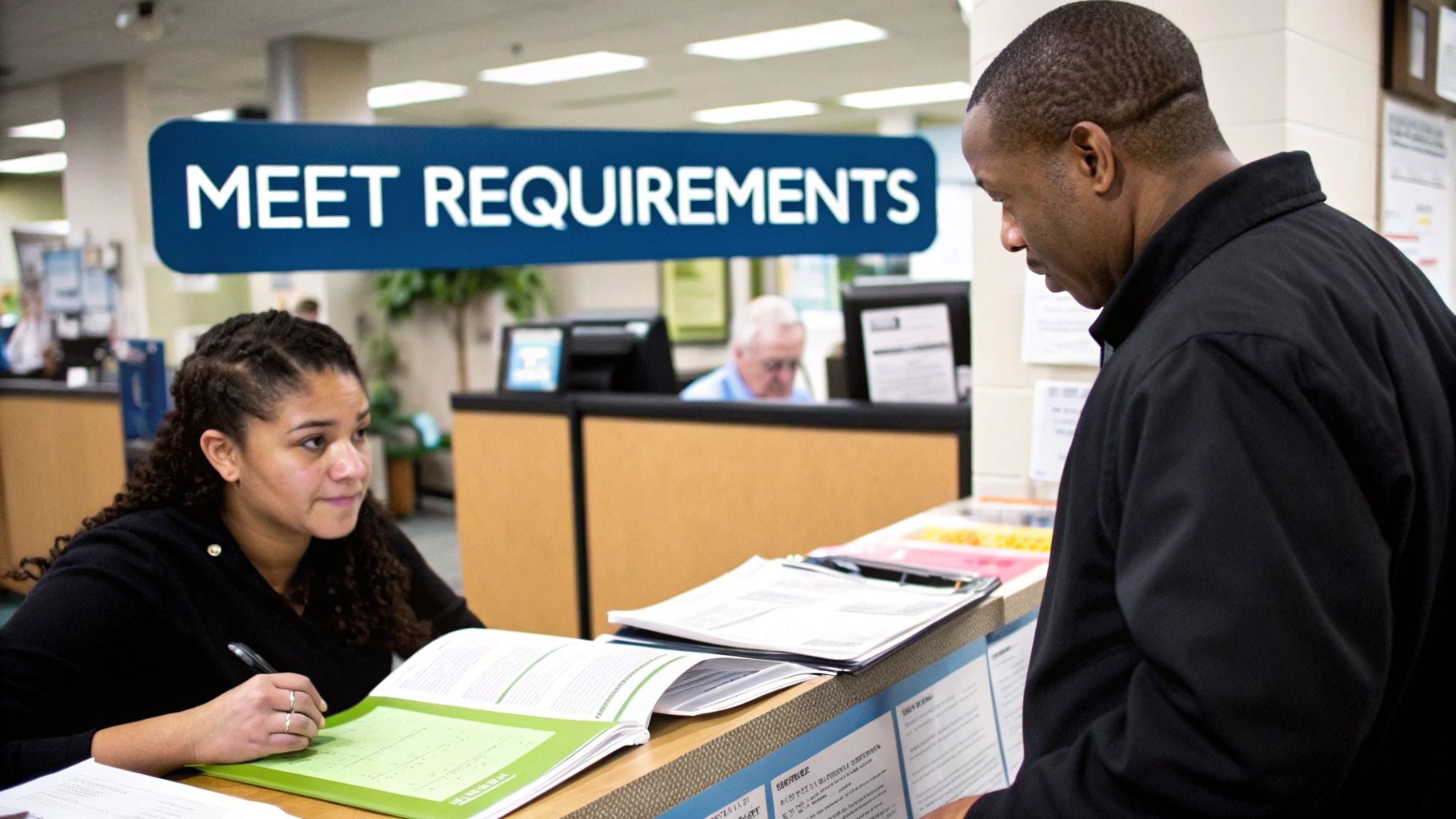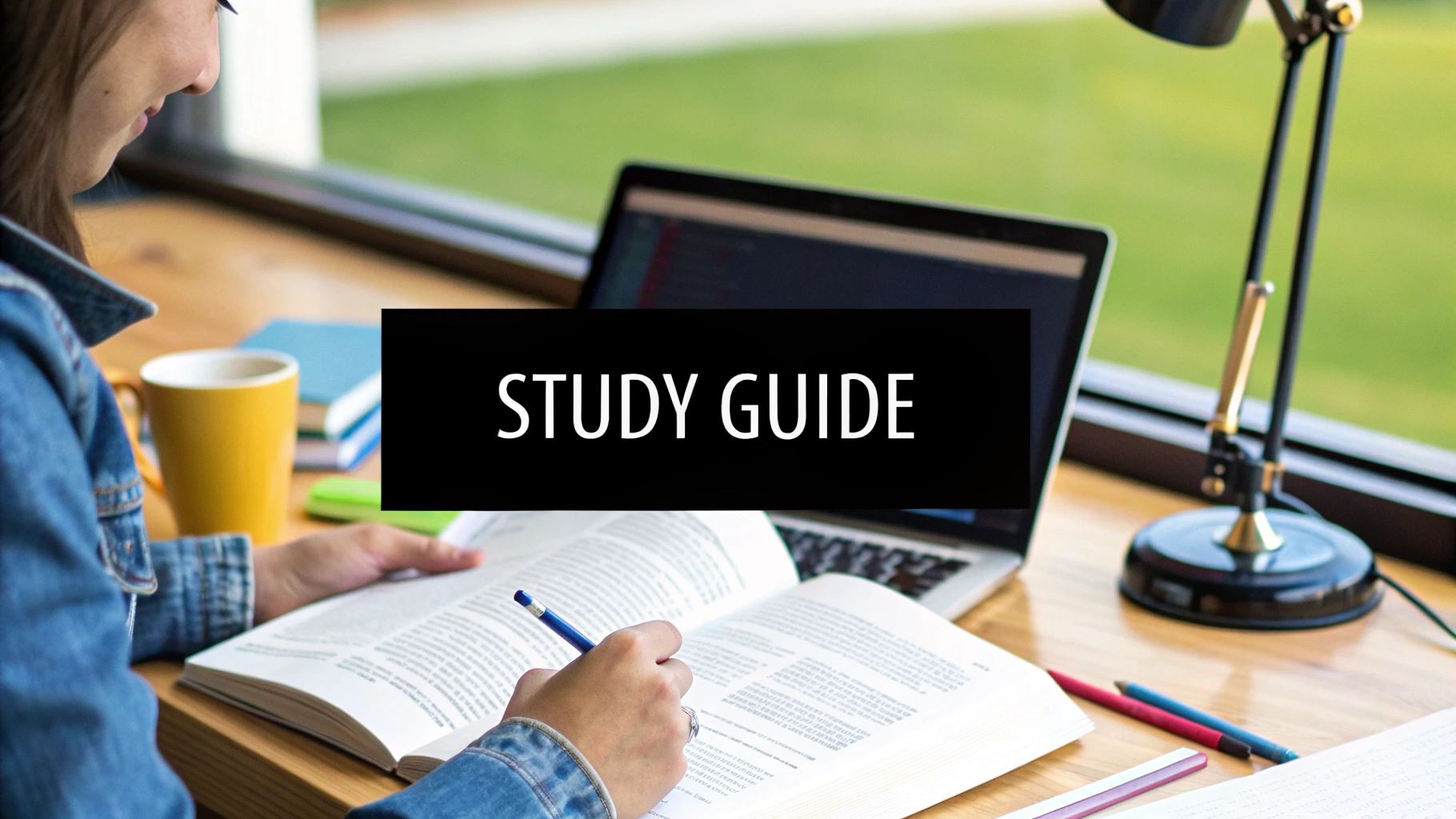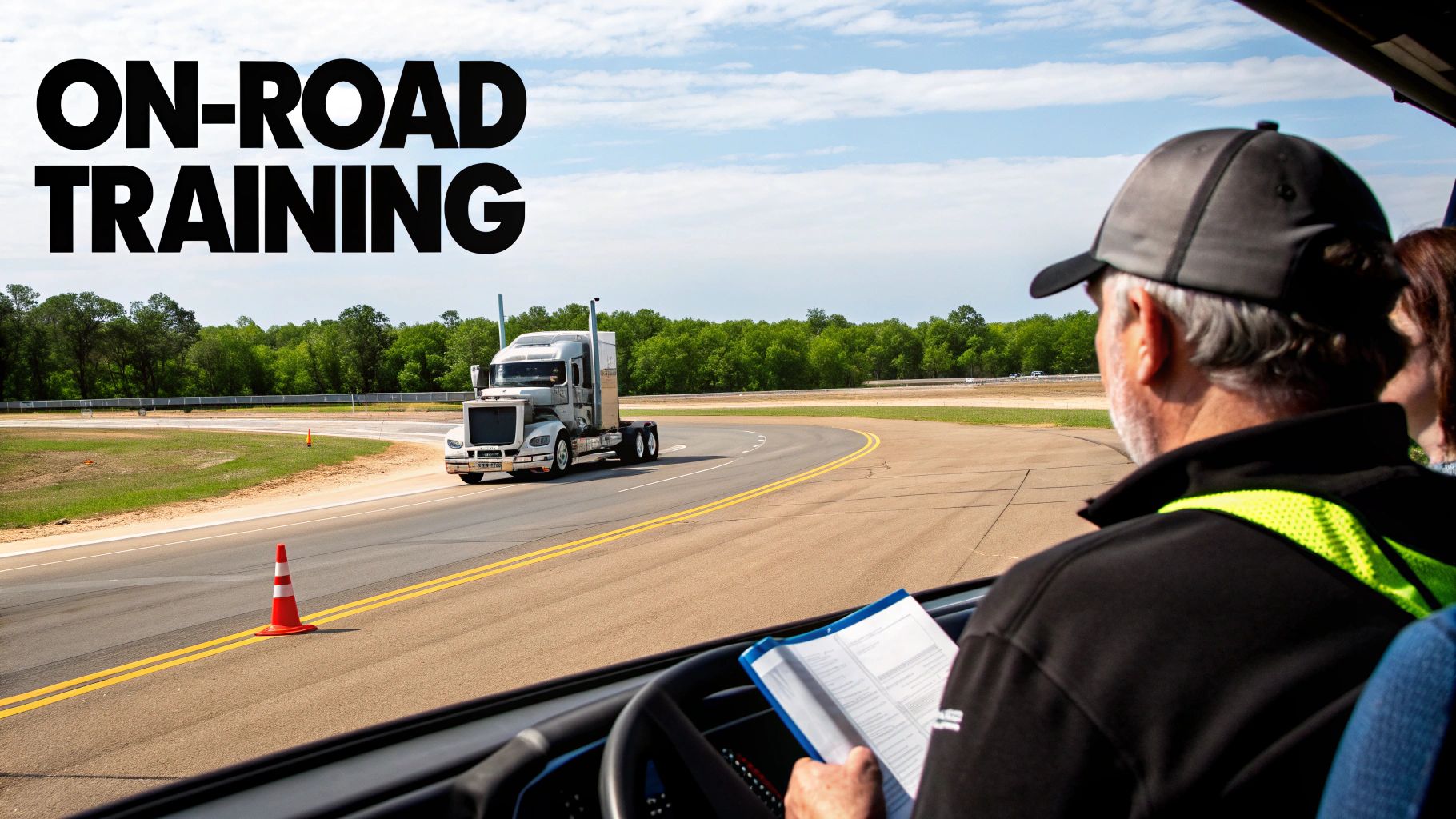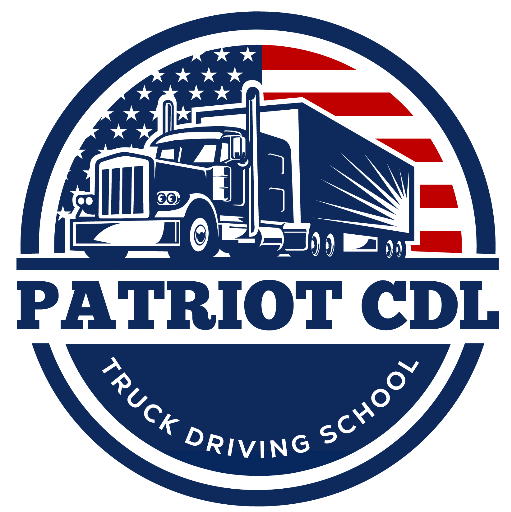Earning your Commercial Driver's License (CDL) is a journey with a few key milestones. It starts with meeting the basic requirements, then moves to passing the written permit test, getting solid professional training, and finally, proving your skills in the final exam. Think of it as a logical path from book smarts to real-world, hands-on ability.
This guide will walk you through every one of those steps, giving you a clear roadmap to follow.
Your Roadmap to a Commercial Driver's License

Starting down the path to get your CDL isn't just about learning to handle a big rig—it's your entry into a profession that our country absolutely depends on. The entire process is built to layer your skills one on top of the other, making sure you’re not just licensed, but truly safe and confident behind the wheel.
The need for qualified drivers is massive. Right now, industry estimates show a shortage of roughly 80,000 truck drivers across the nation. This isn't a temporary blip; it's driven by a wave of retiring drivers and the non-stop growth of online shopping, which means more goods are moving on our roads than ever before.
This isn't just a job; it's a career with staying power. The skills you acquire while learning how to get a CDL license are valuable assets that provide long-term job security in an essential industry.
Understanding the CDL Framework
Before we get into the nitty-gritty, it helps to understand the "why" behind the process. The path to getting your license is structured to ensure every new driver has both the knowledge and the practical skills to safely operate a commercial motor vehicle (CMV). This is less about just passing a test and more about preparing you for the realities of the road.
Here’s a quick look at what you can expect:
- Checking Your Eligibility: First things first, you have to make sure you meet the baseline age, medical, and legal standards.
- Getting Your Permit: This involves passing a written knowledge test to get your Commercial Learner’s Permit (CLP), which is your ticket to start practicing behind the wheel with a licensed instructor.
- Hands-On Training: You'll attend a certified school to learn everything from basic vehicle controls to tricky backing maneuvers. This is where theory meets practice.
- Nailing the Skills Test: This is the final exam. It's a three-part test covering a vehicle inspection, basic control skills, and an on-road driving evaluation.
A huge piece of that final test—and your daily life as a driver—is the vehicle inspection. You absolutely have to master this to pass the exam and ensure your truck is safe every single day. You can get a head start by reviewing our detailed guide on the CDL pre-trip inspection. Each step in this process builds on the one before it, giving you a strong foundation for a long, safe career in trucking.
Confirming Your CDL Eligibility First
Before you even think about cracking open a study guide or looking at truck driving schools, your very first step is to make sure you actually qualify for a CDL. Trust me, this isn't just a box to check—it's the foundation of your entire career. Getting this sorted out now saves you from major headaches and dead ends later.
There’s a good reason these rules exist. It wasn’t always this standardized. Before the federal government got involved with the Motor Carrier Safety Act of 1984, state rules were all over the map, which created some serious safety issues. Today's CDL system ensures everyone meets the same core standards.
Age and Driving Record Requirements
First up, let’s talk age. The rules change depending on where you plan to haul. If you’re sticking to intrastate routes (meaning, you’re only driving within your home state), the minimum age is typically 18.
But if you want to cross state lines for interstate commerce—which is where most of the long-haul jobs are—the federal government requires you to be at least 21 years old. No exceptions.
Your regular driving record is also going to be put under a microscope. A clean history is non-negotiable. Major violations like a DUI, reckless driving, or leaving the scene of an accident can stop you in your tracks. States want to see a pattern of responsibility before they’ll even consider letting you get behind the wheel of an 80,000-pound rig.
If you have any questions about your own driving history, our detailed breakdown of CDL requirements can give you a clearer picture of what might be a red flag.
Medical Fitness and Documentation
Every single person who wants a CDL has to pass a Department of Transportation (DOT) physical. This isn't your typical annual check-up; it's a specialized exam designed to confirm you’re medically fit for the job.
A certified medical examiner will look closely at anything that could affect safety on the road. They’ll check your:
- Vision and Hearing: You have to meet minimum standards, but it’s okay if you use glasses or hearing aids to get there.
- Blood Pressure: High blood pressure is a common issue, but it must be well-managed.
- Medical History: Some conditions, like epilepsy or insulin-dependent diabetes, might require a special waiver or could be disqualifying.
Once you pass, you’ll be issued a DOT Medical Certificate. You cannot get your Commercial Learner’s Permit (CLP) or your CDL without this piece of paper. It's an absolute must-have.
Lastly, get your documents in order before you head to the DMV. You'll need to prove you're a U.S. citizen or a lawful permanent resident. You’ll also need to show proof of residency in your state, which can usually be a recent utility bill or a rental agreement. Having all your paperwork ready to go will make your visit a whole lot smoother.
Passing Your Commercial Learner's Permit Exam

Alright, you’ve confirmed you're eligible to become a trucker. The next big hurdle is getting your Commercial Learner's Permit, or CLP.
Think of the CLP as your "license to learn." It’s the official document that allows you to get behind the wheel of a big rig, as long as you have a licensed CDL holder in the passenger seat. You can't start your hands-on training without it, making it the critical link between knowing the rules of the road and actually driving on them.
The whole process of getting a CDL is designed to build your skills from the ground up, and it all starts here. To earn your permit, you’ll need to pass a written knowledge test that proves you've got the essential theory down cold.
What to Study for the CLP Test
Forget about guesswork. Your single most important study resource is your state's official CDL manual. I can't stress this enough—the test questions come directly from that book. Don't just flip through it; this manual needs to be your new best friend for a couple of weeks.
For a Class A license, the permit exam almost always zeroes in on three core topics. Make sure you know them inside and out:
- General Knowledge: This is the big one. It covers everything from basic vehicle control and seeing hazards to handling emergencies and managing cargo.
- Air Brakes: You have to prove you understand exactly how air brake systems function, how to do a proper pre-trip inspection on them, and what all those hisses and pops really mean.
- Combination Vehicles: This section is all about the unique physics of driving a tractor-trailer. You'll be tested on things like coupling and uncoupling, turning correctly, and preventing the dangerous "crack-the-whip" effect.
Here's a pro tip: Don't just study to pass the test. Study to understand. The information in that manual isn't just for the DMV—it's the foundation that will keep you safe on the road for your entire career.
Smart Study Strategies That Actually Work
Trying to read the CDL manual from cover to cover in one sitting is a recipe for burnout. A much better way to tackle it is to break the material into smaller chunks.
Here's an approach that works for a lot of people: read a single chapter, then immediately find an online practice test covering only that chapter. This method locks in the information while it's still fresh and shows you exactly what you didn't quite grasp.
Many successful drivers made the CDL manual a constant companion. Keep a copy in your truck to read on your lunch break, or get the PDF on your phone to review whenever you have a few spare minutes. Short, frequent study sessions are far more effective than a last-minute cram session.
For a deeper dive into this part of the journey, check out our guide on how to get your commercial learner's permit. It’s packed with more specific tips.
Once you’re consistently passing those practice tests and feel you have a solid handle on the material, it’s time. Head down to your local DMV, pay the fees, and get ready to ace that exam.
Finding the Right CDL Training Program
Okay, you've got your Commercial Learner's Permit in hand. That’s a huge step. Now comes the decision that will shape the very start of your trucking career: choosing where to train. This isn't just about learning enough to pass a test. The right program builds the foundation for your skills, your safety habits, and can even help you land that crucial first job.
There are a few well-traveled roads to getting your CDL, and each has its own set of pros and cons. You’re mainly looking at three options: private truck driving schools, programs at community colleges, and training sponsored by a trucking company. Figuring out which one fits your budget, your timeline, and what you want out of your career is key.
Before we dive into the schools, let's talk about the standard fees you'll run into. The image below gives you a good snapshot of the typical costs you can expect, no matter which training path you take.

Keep in mind, these are just the administrative costs. Your single biggest investment by a long shot is going to be your tuition for the actual hands-on training.
To help you get a clearer picture of your main options, let's break them down. Each path offers something different, so what's perfect for one person might not be the best fit for another.
Comparison of CDL Training Options
| Feature | Private Truck Driving School | Community College Program | Company-Sponsored Training |
|---|---|---|---|
| Typical Duration | Fast-paced (3-7 weeks) | Slower (Full semester) | Varies (often 4-8 weeks) |
| Upfront Cost | Highest ($3,000 – $10,000+) | Moderate (Financial aid may be available) | Low to none (covered by the company) |
| Flexibility | High (graduate and work for anyone) | High (work for any carrier) | Low (contractually obligated to one company) |
| Best For | Getting on the road and earning quickly | Students needing a part-time schedule or college credit | Individuals with limited upfront funds |
This table gives you a bird's-eye view, but the real story is in the details of how these programs work day-to-day.
Private Schools vs. Community Colleges
Private truck driving schools are all about speed. They have one mission: get you trained, tested, and licensed as fast as humanly possible. We're talking programs that can have you ready for your skills test in just three to seven weeks. If your top priority is to start earning a paycheck, this is often the quickest way to do it.
Community college programs take a different approach. They usually stretch the training out over a full semester, which is a fantastic option if you need to keep your current job while you learn. The pace is more measured, and you might even earn some college credits, but you won't get the rapid turnaround of a dedicated private school.
The Deal with Company-Sponsored Training
You’ll see this option everywhere—"paid" CDL training. Big carriers are always looking for new drivers, and they’ll offer to front the cost of your schooling. In return, you sign a contract agreeing to drive for them for a set amount of time, usually at least a year.
This route is incredibly popular because it removes the massive upfront cost of tuition. But there's a serious trade-off: your freedom. If you get a few months in and realize the company is a bad fit, you can't just walk away. Breaking that contract often means you're on the hook for the full cost of your training, which can be several thousand dollars.
Think this through carefully. Paying for your own school is a bigger hit to your wallet at first, but it gives you the ultimate freedom to choose your employer once you have that CDL. That's a powerful position to be in.
No matter which path you lean toward, you need to do your homework and vet any potential school. Before you sign a single piece of paper, ask some direct questions.
- What's the instructor-to-student ratio? You need real, hands-on time behind the wheel, not just sitting in the back of a cab with five other students.
- How old is the equipment? Learning on modern trucks that are well-maintained is critical. You don't want to test in a relic from the 90s.
- What kind of job placement assistance do you offer? A quality school has solid connections with good carriers and a vested interest in seeing you get hired.
Choosing your training program is one of the most important decisions you'll make. A smart choice here sets you up for a safe, successful, and long career on the open road.
Acing Your Final CDL Skills Test

This is it—the final challenge. Everything you’ve learned and practiced comes down to this three-part practical skills test. This is what stands between you and your CDL.
But don't let the pressure get to you. The exam isn't designed to trick you. It’s a straightforward, hands-on evaluation to make sure you can safely handle a commercial vehicle according to federal standards.
The whole thing is broken down into three separate parts, and you have to pass each one to move on to the next. Let's walk through exactly what to expect so you can show up on test day feeling prepared and confident.
Mastering the Pre-Trip Inspection
The very first hurdle you have to clear is the Vehicle Inspection Test. Before you even turn the key, you need to prove to the examiner that you know your truck inside and out. You're their eyes, showing them you can spot any safety problem before it becomes a disaster on the road.
This isn't just about pointing at things. You need a system. A solid routine—like starting at the front bumper and working your way around clockwise—is your best friend here. As you check each component, you have to tell the examiner exactly what you’re looking for.
For instance, when you get to a tire, don't just say "checking the tire." You need to say you're checking for proper inflation, looking for even tread wear, and inspecting the sidewalls for any cuts or bulges. The best drivers I know create a script and practice it relentlessly until it’s muscle memory. That way, you won't miss a single critical item.
Nailing the Basic Control Skills
After you pass the inspection, you'll head over to the Basic Control Skills test. This part happens on a closed course or a big, empty lot, safely away from traffic. The whole point is to see how well you can maneuver that big rig in tight quarters.
You’ll be asked to perform a few specific backing maneuvers. The exact ones can vary, but they almost always include some version of these:
- Straight Line Backing: Sounds simple, but it’s foundational. You'll need to back the truck and trailer in a perfectly straight line for about 100 feet.
- Offset Backing: This simulates changing lanes in reverse. You'll back into a lane that's just to the left or right of your current one.
- Alley Dock: This is the one that trips up a lot of new drivers. You’ll have to back your trailer into a space at a 90-degree angle, just like you would at a real loading dock.
The secret to passing these maneuvers? Slow is smooth, and smooth is fast. Make small, tiny steering corrections and live in your mirrors. The number one mistake people make is over-steering, which gets them into trouble real quick.
Executing the On-Road Driving Test
The final piece of the puzzle is the On-Road Driving Test. This is where you, the examiner, and the truck head out into actual traffic. The examiner will be right there in the passenger seat, watching your every move.
They're looking for proof that you can safely manage the truck in the real world. This means navigating intersections, controlling your speed on hills, changing lanes properly, and just generally interacting safely with all the other cars on the road.
They want to see you constantly checking your mirrors, signaling way ahead of time, and always keeping a safe cushion of space around your vehicle. This is where all that book learning from the general knowledge test comes to life.
Stay calm, stay focused, and just drive safely. And hey, if you don't pass on your first attempt, it's not the end of the world. It happens. You can just reschedule and give it another shot.
Expanding Your Career with CDL Endorsements
https://www.youtube.com/embed/J2BAOaTH3FM
Getting your CDL is a huge milestone, but honestly, it’s just the starting line. Your license is the foundation, and endorsements are the specializations that build a real career on top of it. These certifications unlock entirely new job possibilities, almost always leading to better pay and more interesting work.
When you add an endorsement, you're signaling to employers that you’ve gone the extra mile. You’re showing them you have the specific skills and knowledge needed to handle specialized cargo or vehicles, which immediately boosts your value in the industry.
Unlocking Higher-Paying Opportunities
Let's be real—not all trucking jobs are the same. Endorsements are your ticket to the more lucrative and sought-after positions. Most require you to pass additional written knowledge tests, while others, like the Hazmat endorsement, also include a full federal background check.
Here’s a look at some of the most common—and valuable—endorsements you can get:
-
Tanker (N): A must-have for hauling any kind of liquid or gas, whether it's milk, fuel, or chemicals. The test focuses on the unique physics of handling "liquid surge"—that sloshing motion that can seriously affect how your truck handles.
-
Hazardous Materials (H): This is your "Hazmat" certification. It lets you transport anything the government classifies as hazardous. You'll need to pass a specific written exam and a Transportation Security Administration (TSA) threat assessment.
-
School Bus (S): If you want to transport the most precious cargo of all—kids—this one is non-negotiable. It involves a written test, a driving skills test in a school bus, and, as you can imagine, very comprehensive background checks.
Thinking about which endorsements you want before you even finish your initial CDL training is a smart play. It lets you aim your career toward the jobs you actually want instead of just settling for what's available.
Endorsements can also remove limitations. For example, many new drivers get a restriction on their license that only allows them to drive trucks with automatic transmissions. If you want to open up every possible job opportunity, taking an E restriction removal course will get you trained and tested on a manual CMV, making you a much more versatile and valuable hire.
Common Questions About Getting Your CDL
When you're first looking into getting your commercial license, it’s natural to have a lot of questions. Knowing what to expect in terms of time and money can make the whole process feel much more manageable. Let’s clear up a few of the most common things people ask.
How Long Will It Take to Get My CDL?
This is probably the number one question, and the honest answer is: it depends on the path you take.
If you’re able to jump into a full-time, dedicated truck driving school, you could be looking at a pretty quick turnaround. Many of these accelerated programs can get you ready for your final skills test in as little as three to seven weeks.
On the other hand, if you need to keep your current job while you train, a part-time program might be a better fit. Community colleges often offer these, and while they give you flexibility, they naturally stretch the timeline out over several months. Both routes will cover everything from studying for your CLP to completing the required Entry-Level Driver Training (ELDT) and passing that final exam.
What's the Average Cost to Get a CDL?
Budgeting for your CDL is crucial, and you can generally expect the total investment to fall somewhere between $3,000 and $10,000. That's a wide range, I know. The final price tag really depends on the school's location, its reputation, and how intensive the program is.
A good piece of advice: don't forget the smaller fees. You'll need to budget for things like your commercial learner's permit, the final licensing fee, your DOT medical exam, and any tests for extra endorsements you want. They add up!
Do I Need My Own Truck for the Driving Test?
Absolutely not. This is a common worry, but you can put it out of your mind.
When you train with a professional CDL school, they provide the truck for all your behind-the-wheel practice and, most importantly, for the official skills test. They’ll make sure the vehicle matches the license class you're testing for (like a Class A tractor-trailer) and that it passes a full safety inspection before your exam even starts.
Ready to stop asking questions and start driving? The expert instructors at Patriot CDL are here to guide you through every step of the process, from getting your permit to acing the final exam. Start your journey on the open road with us by visiting the Patriot CDL website.
